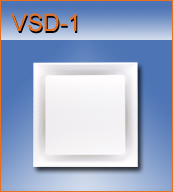Diffusers - Variable Volume
ADVANTAGES
- Electric actuator
- Optional electric reheat
- Drone option
- Reversing change-over
- Remote setpoint option
- No routine maintenance
- ARI certified performance
The RICKARD VARIABLE VOLUME VARI-DISC CEILING DIFFUSER
The Rickard variable volume Vari-Disc ceiling diffuser is designed for general building zones where uniform radial discharge is the most suitable and desirable supply air distribution pattern. The basic diffuser is available in a wide range of options to suit every individual requirement.
Optimum performance in terms of uniform air distribution and low noise levels has been combined with simple construction and aesthetically pleasing appearance to provide a unit which is both functional and reliable. All diffusers have a steel construction and are finished in a chip resistant baked white acrylic paint. Custom colors are available.
Room temperature is controlled by varying the supply air volume in accordance with demand. Volume control is achieved by moving a disc, known as the control disc, vertically up and down in the diffuser so as to vary the aperture through which air passes. This results in the “VARIABLE GEOMETRY” concept which effectively maintains constant air movement in the room throughout the range of control, from 100% down to approximately 30%.
The position of the control disc is varied by means of a pneumatic or electric actuator which drives the disc in response to a signal received from the temperature controller. When used with the RICKARD controller, the diffuser will control room temperature on a proportional-integral basis. Air is discharged in a 360 degree horizontal pattern. Maximum and minimum air volumes may be adjusted to suit the particular design conditions. For a detailed description of VAV systems refer to Section 1 of this catalogue.
Although the diffusers require no routine preventative maintenance, all mechanical components as well as the actuator and controller are accessible from below the ceiling. As a result of the “modular” design of the diffusers, changing components does not require highly skilled labor and can be carried out with minimal disruption to room occupants.
DIFFUSER SELECTION
GENERAL
The first consideration when designing a system is to calculate the required air volume and temperature to satisfy room conditions at maximum heat loads. It is recommended that ducting is sized using the static-regain method. Velocities in branch ducts should be in the range 650 - 1200 ft/min. Thereafter the following should be considered:
THROW
This is the distance from the diffuser at which the air velocity has slowed to 50 ft/min when measured 1 in. below the ceiling (or from the wall) with the diffuser in the fully open position. Coning occurs when two airstreams traveling in opposite directions meet and result in a downward moving cone of air. Ideally diffusers should be spaced such that the distance between two diffusers is slightly less than the sum of their throws. Throw remains essentially constant throughout the range of air flow rates, a feature of the variable geometry diffuser.
DUCT STATIC PRESSURE
Diffuser performance has been established using diffuser neck total pressure, although what is normally known and controlled is duct static pressure. What happens between the duct and the diffuser depends on the length and type of flexible duct.
For simplicity, it can be assumed that duct static pressure approximates diffuser neck total pressure. This is a valid assumption for systems where flexible duct lengths are not excessive. The above can be explained briefly as follows: The static pressure loss due to friction in the flexible duct (±0.05 in.w.g.) would normally be about the same as the velocity pressure in the diffuser neck and since total pressure is the sum of static and velocity pressures, we can say that neck total pressure is approximately the same as duct static pressure. Although the tables give diffuser performance for neck total pressures ranging from 0.08 - 0.40 in.w.g., caution should be exercised when selecting diffusers outside the range of 0.16 - 0.32 in.w.g. At lower pressures air movement and induction may be insufficient and at higher pressures drafts and excessive noise may result. Best results are obtained when diffusers are selected at pressures of 0.20 - 0.30 in.w.g. Bear in mind that all diffusers on a particular branch will operate at the same static pressure as controlled by the pressure control damper. Diffusers which are able to supply more air than required will be driven partially closed by the temperature controller and the system will self balance.
NOTE: Avoid placing restrictions (such as manually operated dampers or pinched flexible ducts) at any point in branch ducts. The result is that at maximum flow these restrictions result in a significant static pressure loss (which for some cases may be desirable) but at minimum flow conditions offer virtually no resistance, which will result in the static pressure at the diffuser being too high.
CONTROLS
GENERAL DESCRIPTION
The Vari-Disc diffuser can be supplied complete with electronic controls to give accurate and reliable proportional-integral cooling control to maintain a constant room temperature.
REVERSING CHANGE-OVER
The Reversing change-over module is a plug-in conversion. A change-over sensor can be plugged into the Triac PCB, Interface PCB or Master control board. This changes the actuator from direct to reverse acting unit during winter when warm air is supplied. Normally, as the temperature sensed rises, the air volume from the terminal increases, while in the reverse mode, the air volume from the terminal will increase as the room temperature decreases. Practically, this means the system will be varying the volume of cold air to cool in summer and varying the volume of warm air to heat in winter. It is preferable to plug the change over sensor into the Triac PCB or Interface PCB so that you can easily mount the sensor in the supply air stream. Care must be taken to ensure that if the diffuser has a heater installed, this sensor is installed in such a way that it is not affected by radiant heat from the heater.

